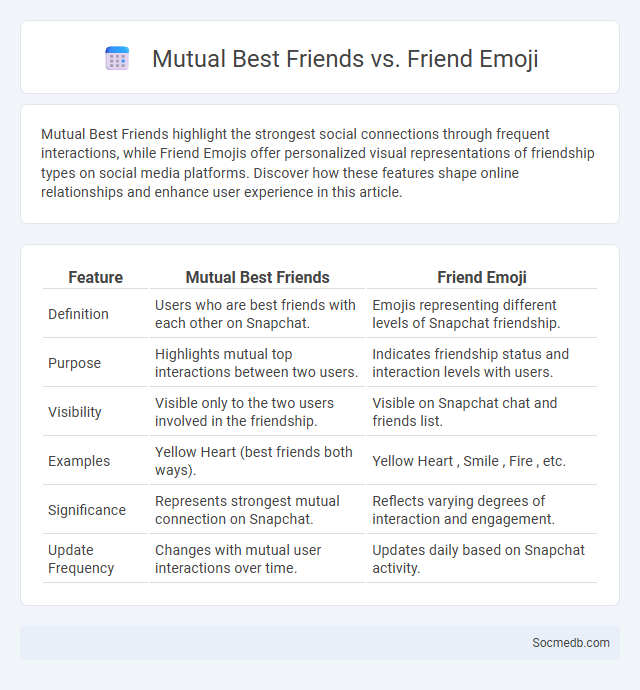
Photo illustration: Mutual Best Friends vs Friend Emoji
Mutual Best Friends highlight the strongest social connections through frequent interactions, while Friend Emojis offer personalized visual representations of friendship types on social media platforms. Discover how these features shape online relationships and enhance user experience in this article.
Table of Comparison
| Feature | Mutual Best Friends | Friend Emoji |
|---|---|---|
| Definition | Users who are best friends with each other on Snapchat. | Emojis representing different levels of Snapchat friendship. |
| Purpose | Highlights mutual top interactions between two users. | Indicates friendship status and interaction levels with users. |
| Visibility | Visible only to the two users involved in the friendship. | Visible on Snapchat chat and friends list. |
| Examples | Yellow Heart (best friends both ways). | Yellow Heart , Smile , Fire , etc. |
| Significance | Represents strongest mutual connection on Snapchat. | Reflects varying degrees of interaction and engagement. |
| Update Frequency | Changes with mutual user interactions over time. | Updates daily based on Snapchat activity. |
Understanding Mutual Best Friends: Definition and Significance
Mutual best friends on social media refer to individuals who share a reciprocal close connection through interactions, likes, comments, and shared experiences on platforms like Facebook and Instagram. This relationship indicates trust, frequent engagement, and a higher likelihood of content visibility within your network, enhancing online presence and connection quality. Understanding mutual best friends helps optimize social media strategies by focusing on meaningful interactions that foster genuine engagement and community growth.
What is the Friend Emoji? A Guide to Snapchat Symbols
The Friend Emoji on Snapchat represents the level of interaction between users and their friends, visually indicating the status of their friendship. These symbols include icons like the yellow heart, which signifies best friends who frequently exchange snaps, and the smiling face, indicating mutual best friends. Understanding these Snapchat symbols helps users track their social connections and engagement within the app more effectively.
Mutual Best Friends vs Friend Emoji: Key Differences
Mutual Best Friends on social media platforms indicate a high level of reciprocal engagement, often reflecting consistent interactions such as messaging, commenting, and sharing content. Friend Emojis, like the yellow heart or smiley face, symbolize specific styles of friendship or interaction frequency but may not necessarily imply mutual activity. Understanding these distinctions helps users interpret social dynamics and engagement levels more accurately within platforms like Snapchat and Instagram.
How Snapchat Determines Mutual Best Friends
Snapchat determines mutual best friends by analyzing the frequency and patterns of interactions between users, including snaps sent, received, and chat activity. The algorithm prioritizes reciprocal engagement, highlighting contacts with whom both parties frequently communicate. This data-driven approach allows Snapchat to feature mutual best friends based on shared activity metrics rather than just one-sided interactions.
The Role of Friend Emojis in Snapchat Friendships
Friend emojis on Snapchat play a crucial role in enhancing social interactions by visually representing the status and strength of your friendships. These emojis encourage users to engage more frequently, fostering stronger bonds through gamified communication patterns. Understanding the meaning behind each friend emoji helps you navigate and deepen connections within your Snapchat network effectively.
Benefits of Having Mutual Best Friends on Social Platforms
Having mutual best friends on social media enhances trust and deepens connections by creating a shared network of support and understanding. These relationships foster increased engagement through reciprocal interactions such as comments, likes, and shared content, boosting social presence and visibility. Moreover, mutual best friends facilitate reliable information exchange and emotional support, contributing to stronger online communities and improved mental well-being.
How to Achieve Mutual Best Friends Status
Building mutual best friends status on social media requires consistent, genuine interaction and active engagement with each other's content. You can achieve this by regularly liking, commenting, and sharing meaningful posts while maintaining open and supportive communication. Prioritizing trust and shared experiences will strengthen your online friendship and create a lasting digital bond.
Privacy Concerns: Emoji Indicators vs Mutual Friend Lists
Privacy concerns on social media platforms often center around how user interactions and connections are displayed, with emoji indicators offering a visually intuitive yet less invasive alternative to mutual friend lists. Emoji indicators can signal shared interests or reactions without revealing the full scope of a user's social network, thereby enhancing privacy while maintaining engagement. In contrast, mutual friend lists expose direct relationships, potentially compromising personal data and increasing the risk of unwanted exposure or profiling.
Social Dynamics: Interpreting Friendship Levels
Social dynamics on social media platforms reveal varying friendship levels based on interaction patterns such as likes, comments, and direct messages. Your engagement frequency and content sharing contribute to perceived closeness, influencing algorithms that prioritize posts from closer connections. Understanding these signals helps you navigate online relationships more effectively, enhancing meaningful digital communication.
Mutual Best Friends vs Friend Emoji: Which Matters More?
Mutual Best Friends indicate a stronger social bond by showing shared connections, which can enhance trust and engagement on social media platforms. The Friend Emoji, while symbolic of friendship, often represents casual or surface-level interactions and may not reflect deeper relationships. Understanding the difference helps you prioritize meaningful connections over superficial likes and comments, fostering a more authentic online community.
 socmedb.com
socmedb.com